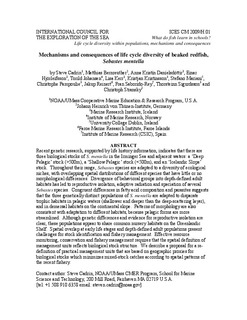| dc.contributor.author | Cadrin, Steven X. | |
| dc.contributor.author | Bernreuther, Matthias | |
| dc.contributor.author | Daníelsdóttir, Anna Kristín | |
| dc.contributor.author | Hjörleifsson, Einar | |
| dc.contributor.author | Johansen, Torild | |
| dc.contributor.author | Kerr, Lisa | |
| dc.contributor.author | Kristinsson, Kristjan | |
| dc.contributor.author | Mariani, Stefano | |
| dc.contributor.author | Pampoulie, Christophe | |
| dc.contributor.author | Reinert, Jákup | |
| dc.contributor.author | Saborido-Rey, Fran | |
| dc.contributor.author | Sigurdsson, Thorsteinn | |
| dc.contributor.author | Stransky, Christoph | |
| dc.date.accessioned | 2012-02-07T08:12:27Z | |
| dc.date.available | 2012-02-07T08:12:27Z | |
| dc.date.issued | 2009 | |
| dc.identifier.citation | This report is not to be quoted without prior consultation with the General Secretary. | no_NO |
| dc.identifier.uri | http://hdl.handle.net/11250/102944 | |
| dc.description.abstract | Recent genetic research, supported by life history information, indicates that there are
three biological stocks of S. mentella in the Irminger Sea and adjacent waters: a ‘Deep
Pelagic’ stock (>500m), a ‘Shallow Pelagic’ stock (<500m), and an ‘Icelandic Slope’
stock. Throughout their range, Sebastes species are adapted to a diversity of ecological
niches, with overlapping spatial distributions of different species that have little or no
morphological differences. Divergence of behavioral groups into depth-defined adult
habitats has led to reproductive isolation, adaptive radiation and speciation of several
Sebastes species. Congruent differences in fatty acid composition and parasites suggests
that the three genetically distinct populations of S. mentella are adapted to disparate
trophic habitats in pelagic waters (shallower and deeper than the deep-scattering layer),
and in demersal habitats on the continental slope. Patterns of morphology are also
consistent with adaptation to different habitats, because pelagic forms are more
streamlined. Although genetic differences and evidence for reproductive isolation are
clear, these populations appear to share common nursery habitats on the Greenlandic
Shelf. Spatial overlap at early life stages and depth-defined adult populations present
challenges for stock identification and fishery management. Effective resource
monitoring, conservation and fishery management requires that the spatial definition of
management units reflects biological stock structure. We describe a proposal for a redefinition
of practical management units that are based on geographic proxies for
biological stocks which minimizes mixed-stock catches according to spatial patterns of
the recent fishery. | no_NO |
| dc.language.iso | eng | no_NO |
| dc.publisher | ICES | no_NO |
| dc.relation.ispartofseries | ICES CM documents;2009/H:01 | |
| dc.subject | redfish | no_NO |
| dc.subject | uer | no_NO |
| dc.title | Mechanisms and consequences of life cycle diversity of beaked redfish, Sebastes mentella | no_NO |
| dc.type | Working paper | no_NO |
| dc.subject.nsi | VDP::Agriculture and fishery disciplines: 900::Fisheries science: 920::Resource biology: 921 | no_NO |
| dc.source.pagenumber | 36 s. | no_NO |
